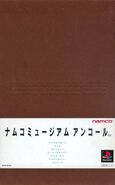(Listed new info on Namco Museum Remix, Virtual Arcade, Essentials and Megamix.) Tag: Visual edit |
(Added info on Namco Museum (Switch).) Tag: Visual edit |
||
| Line 23: | Line 23: | ||
==Namco Museum Vol. 2== |
==Namco Museum Vol. 2== |
||
| − | '''Namco Museum Vol. 2''' was released on February 9th, 1996 in Japan for the Sony PlayStation. It was later released in North America on September 30th, 1996, and in Europe on November 22nd, 1996. |
+ | [[File:Nampo Museum vol. 2 Japanese cover|thumb|152x152px|Original Japanese cover art.]]'''Namco Museum Vol. 2''' was released on February 9th, 1996 in Japan for the Sony PlayStation. It was later released in North America on September 30th, 1996, and in Europe on November 22nd, 1996. |
| − | Like its predecessor, the game presents a large amount of memorabilia and history of the games, within a large museum. The museum is no different from it's predecessor, aside from the fact that the weather outside is different (sunset, rather than midday), and anything relating to the games included has been changed to accommodate for the difference in game library. The collection still uses JAMMA emulation to faithfully recreate the games, which indeed look faithful. Most differences between the original arcade games and these emulations are minor, aside from screen position being changed to accommodate for the PlayStation and it's limited resolution. |
+ | Like its predecessor, the game presents a large amount of memorabilia and history of the games, within a large museum. The museum is no different from it's predecessor, aside from the fact that the weather outside is different (sunset, rather than midday), and anything relating to the games included has been changed to accommodate for the difference in game library. The collection still uses JAMMA emulation to faithfully recreate the games, which indeed look faithful. Most differences between the original arcade games and these emulations are minor, aside from screen position being changed to accommodate for the PlayStation and it's limited resolution. |
| + | |||
| + | This compilation contains the following games, in order of when they are said in the commercial: |
||
*[[Cutie Q|''Cutie Q'']] |
*[[Cutie Q|''Cutie Q'']] |
||
*''[[Xevious]]'' |
*''[[Xevious]]'' |
||
| Line 70: | Line 72: | ||
==Namco Museum Vol. 5== |
==Namco Museum Vol. 5== |
||
| ⚫ | |||
[[File:C) Cover.|thumb|220x220px|Namco Museum Vol. 5 (NTSC-U/C) cover art.]] |
[[File:C) Cover.|thumb|220x220px|Namco Museum Vol. 5 (NTSC-U/C) cover art.]] |
||
| ⚫ | |||
| + | |||
Like its predecessors, the game presents a large amount of memorabilia and history of the games, within a large museum, however, like Vol. 3, the museum has been redesigned with a unique architecture, with elevators, stairs, and multiple floors, including a basement for one game, that being ''Baraduke''. It also, like it's predecessors, uses JAMMA emulation to recreate the games, which is done really well here. |
Like its predecessors, the game presents a large amount of memorabilia and history of the games, within a large museum, however, like Vol. 3, the museum has been redesigned with a unique architecture, with elevators, stairs, and multiple floors, including a basement for one game, that being ''Baraduke''. It also, like it's predecessors, uses JAMMA emulation to recreate the games, which is done really well here. |
||
| Line 239: | Line 242: | ||
==Namco Museum DS== |
==Namco Museum DS== |
||
| ⚫ | |||
[[File:Namco Museum DS cover.jpg|thumb|171x171px|Namco Museum DS (PAL) box art.]] |
[[File:Namco Museum DS cover.jpg|thumb|171x171px|Namco Museum DS (PAL) box art.]] |
||
| ⚫ | |||
| + | |||
DS is a substantial collection compared to the previous collections on Nintendo handhelds, and contains not only the games, but features such as a navigation feature (present in ''Galaga'', ''Xevious'', ''The Tower of Druaga'' and ''Super Xevious''.) to help find hidden goodies within games, a jukebox, and even bonus material that made the series different than other compilations when it first released in the 90s. It also has the ability to save high scores, and you can use DS Download Play to either share a game with another, or to play ''Pac-Man Vs.'' in multiplayer with others who don't own the game, which like the original on the Nintendo GameCube, is required to play. |
DS is a substantial collection compared to the previous collections on Nintendo handhelds, and contains not only the games, but features such as a navigation feature (present in ''Galaga'', ''Xevious'', ''The Tower of Druaga'' and ''Super Xevious''.) to help find hidden goodies within games, a jukebox, and even bonus material that made the series different than other compilations when it first released in the 90s. It also has the ability to save high scores, and you can use DS Download Play to either share a game with another, or to play ''Pac-Man Vs.'' in multiplayer with others who don't own the game, which like the original on the Nintendo GameCube, is required to play. |
||
| Line 256: | Line 260: | ||
== Namco Museum Remix == |
== Namco Museum Remix == |
||
| ⚫ | '''''Namco Museum Remix''''' was released on October 23rd, 2007 in North America for the Nintendo Wii. It was later released in Japan on December 6th, 2007, in Europe on April 18th, 2008, and in Australia on May 1st, 2008. It was renamed to '''''Let's Play Together! Namco Carnival''''' in Japan. This name was chosen because the game seemed like an attraction park, so the name was changed as it seemed more accurate. |
||
[[File:Let's Play Together! Namco Carnival cover.jpg|thumb|312x312px|Japanese cover, showing the different title.]] |
[[File:Let's Play Together! Namco Carnival cover.jpg|thumb|312x312px|Japanese cover, showing the different title.]] |
||
| ⚫ | '''''Namco Museum Remix''''' was released on October 23rd, 2007 in North America for the Nintendo Wii. It was later released in Japan on December 6th, 2007, in Europe on April 18th, 2008, and in Australia on May 1st, 2008. It was renamed to '''''Let's Play Together! Namco Carnival''''' in Japan. This name was chosen because the game seemed like an attraction park, so the name was changed as it seemed more accurate. |
||
| + | |||
Remix has a blend of both the old Namco Museum titles, where you have a 3D space to travel, and the newer titles, as it mostly only features the games, with no bonus content to be found in game. This Namco Museum is unique, however for being the first Namco Museum to include a kind of Namco game that wasn't just an arcade game, being ''Gator Panic Remix'', which is based on ''[[Wacky Gator]]'', an attraction game that plays like whack-a-mole. |
Remix has a blend of both the old Namco Museum titles, where you have a 3D space to travel, and the newer titles, as it mostly only features the games, with no bonus content to be found in game. This Namco Museum is unique, however for being the first Namco Museum to include a kind of Namco game that wasn't just an arcade game, being ''Gator Panic Remix'', which is based on ''[[Wacky Gator]]'', an attraction game that plays like whack-a-mole. |
||
The game menus allow you to control Pac-Man with similar controls to ''[[Pac 'n Roll]]'' and roam around the space to access the games by going into one of 6 entrances, one entrance for every Remix title, and one for the arcade, where all the classic games are presented. |
The game menus allow you to control Pac-Man with similar controls to ''[[Pac 'n Roll]]'' and roam around the space to access the games by going into one of 6 entrances, one entrance for every Remix title, and one for the arcade, where all the classic games are presented. |
||
| Line 283: | Line 288: | ||
==Namco Museum Virtual Arcade == |
==Namco Museum Virtual Arcade == |
||
| ⚫ | |||
[[File:Namco Museum Virtual Arcade Xbox 360 front cover.jpg|thumb|312x312px|Cover art for the game, depicting most of the Live Arcade titles included (aside from ''Pole Position'').]] |
[[File:Namco Museum Virtual Arcade Xbox 360 front cover.jpg|thumb|312x312px|Cover art for the game, depicting most of the Live Arcade titles included (aside from ''Pole Position'').]] |
||
| ⚫ | |||
| + | |||
Virtual Arcade is still to this day the largest Namco Museum collection in terms of titles included, being 34, and it includes not only classic games, but also includes Xbox Live Arcade titles, including those like ''Pac-Man Championship Edition''. The game does not support Xbox 360 Achievements, although, this is because all of the Xbox Live Arcade titles have all of their Achievements intact, and available to collect. |
Virtual Arcade is still to this day the largest Namco Museum collection in terms of titles included, being 34, and it includes not only classic games, but also includes Xbox Live Arcade titles, including those like ''Pac-Man Championship Edition''. The game does not support Xbox 360 Achievements, although, this is because all of the Xbox Live Arcade titles have all of their Achievements intact, and available to collect. |
||
| Line 346: | Line 352: | ||
== Namco Museum Megamix == |
== Namco Museum Megamix == |
||
| ⚫ | |||
[[File:Namco Museum Megamix cover.jpg|thumb|302x302px|Cover for the game.]] |
[[File:Namco Museum Megamix cover.jpg|thumb|302x302px|Cover for the game.]] |
||
| ⚫ | |||
| + | |||
Megamix is an update to Remix, being the same game but including more content, as it adds an extra Remix title, being ''Grobda Remix'', an extra 9 arcade games, and a level select feature to all games, excluding ''Cutie Q.'' |
Megamix is an update to Remix, being the same game but including more content, as it adds an extra Remix title, being ''Grobda Remix'', an extra 9 arcade games, and a level select feature to all games, excluding ''Cutie Q.'' |
||
The games included, listed from left to right and top to bottom on the back of the cover: |
The games included, listed from left to right and top to bottom on the back of the cover: |
||
| Line 379: | Line 386: | ||
== Namco Museum (Nintendo Switch) == |
== Namco Museum (Nintendo Switch) == |
||
| + | [[File:Namco Museum (switch) cover art.jpg|thumb|220x220px|Cover image for the game, showing the new logo for the series.]] |
||
| − | A new title in the series, simply titled '''''Namco Museum''''', was released for the Nintendo Switch in 2017. |
||
| + | '''''Namco Museum''''' was released on July 28th, 2017 in all territories for the Nintendo Switch. It was not released on the other 8th generation platforms, the PlayStation 4 and Xbox One for 2 reasons, Xbox One and PS4 already had the [[Arcade Game Series|''Arcade Game Series'']], and it was a Switch exclusive to make the platform stand out more, being only almost 5 months old at the time of release. |
||
| + | This new collection added some features like a challenge mode, where every game has its own challenge to complete, although it's the same challenge every time. There is also a remake of ''[[Pac-Man Vs.]]'', although this version is more comparable to the Nintendo GameCube original, rather than the stripped down and basic version available on Nintendo DS through Namco Museum DS. |
||
| + | |||
| + | The games included, in order of left-to-right in the main menu: |
||
* ''[[Pac-Man]]'' |
* ''[[Pac-Man]]'' |
||
| ⚫ | |||
* ''[[Galaga]]'' |
* ''[[Galaga]]'' |
||
* ''[[Dig Dug]]'' |
* ''[[Dig Dug]]'' |
||
| + | * ''[[The Tower of Druaga]]'' |
||
* ''[[Sky Kid]]'' |
* ''[[Sky Kid]]'' |
||
| ⚫ | |||
* ''[[Rolling Thunder]]'' |
* ''[[Rolling Thunder]]'' |
||
| − | * ''[[ |
+ | * ''[[Galaga '88]]'' |
* ''[[Splatterhouse]]'' |
* ''[[Splatterhouse]]'' |
||
* ''[[Tank Force]]'' |
* ''[[Tank Force]]'' |
||
| ⚫ | |||
| ⚫ | |||
| ⚫ | |||
| ⚫ | |||
== Namco Museum Mini Player == |
== Namco Museum Mini Player == |
||
Revision as of 22:42, 2 March 2020

|
This article/section is a stub. |
|---|---|
| Please help this article by expanding or finishing it. |
Namco Museum (ナムコミュージアム?) is a series of video game compilations containing games created by Namco during the 1980's and the early 1990's. Namco started the Namco Museum compilations on November 22nd, 1995 for the original Sony PlayStation, and they continue to this very day.
Namco Museum Vol. 1
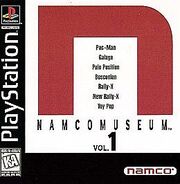
Original North American cover art.
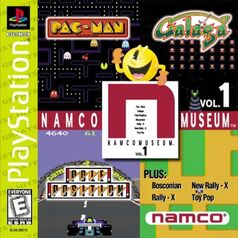
Greatest Hits re-release artwork.
Namco Museum Vol. 1 was released on November 22nd, 1995 in Japan for the Sony PlayStation. It was later released in North America on July 31st, 1996, and in Europe on August 17th, 1996.
The game features a robust amount of history of the games presented and memorabilia and bonuses in a large museum (hence the name) and features emulations of the games using JAMMA emulation. Some games look a bit different from their actual arcade counterparts due to the limited resolution of the PlayStation, like Pac-Man and Galaga. Some games also sound different compared to their arcade counterparts, such as Pac-Man sound effects (Pac-Dots, Power Pellet, etc.) and the music of Toy Pop.
It is one of two Namco Museum titles to do well enough on PlayStation to be given a Greatest Hits re-release, the other being Namco Museum Vol. 3.
This compilation contains the following games, in the order of when they are said in the commercial:
Namco Museum Vol. 2

Original Japanese cover art.
Namco Museum Vol. 2 was released on February 9th, 1996 in Japan for the Sony PlayStation. It was later released in North America on September 30th, 1996, and in Europe on November 22nd, 1996.
Like its predecessor, the game presents a large amount of memorabilia and history of the games, within a large museum. The museum is no different from it's predecessor, aside from the fact that the weather outside is different (sunset, rather than midday), and anything relating to the games included has been changed to accommodate for the difference in game library. The collection still uses JAMMA emulation to faithfully recreate the games, which indeed look faithful. Most differences between the original arcade games and these emulations are minor, aside from screen position being changed to accommodate for the PlayStation and it's limited resolution.
This compilation contains the following games, in order of when they are said in the commercial:
- Cutie Q
- Xevious
- Mappy
- Gaplus
- Grobda
- Dragon Buster
- Super Pac-Man (only in the western version)
- Bomb Bee (only in the Japanese version, hidden)
The original Japanese release included Cutie Q and Bomb Bee (as a hidden game), which were instead replaced with Super Pac-Man in all non-Japanese releases.
Bomb Bee is unlocked by inputting a code while Cutie Q is starting up.The code is: Circle x7, Square x6 and X/Cross x5. Doing this will unlock the game if done correctly, but you must input the code before the color test looking screen pops up on Cutie Q.
There is also a glitch which prevents Dragon Buster from properly displaying the high score like the other games while being played. The high scores can be seen in the record book, however, so it's more so a minor inconvenience. This glitch occurs in every region.
Namco Museum Vol. 3
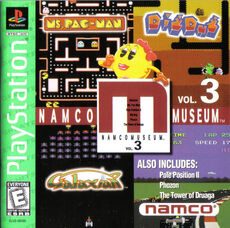
Namco Museum Vol. 3 (Greatest Hits) cover art.
Namco Museum Vol. 3 was released on June 21st, 1996 in Japan for the Sony PlayStation. It was later released in North America on January 31st, 1997, and in Europe on February 12th, 1997.
Like its predecessors, the game presents a large amount of memorabilia and history of the games, within a large museum, however the museum has been redesigned, and the layout of the museum has been changed, along with the game library. These changes bring a new lobby, a new main hall, multiple floors, newly designed rooms for specific art assets and the sound test, and even specially designed hallways towards the game room (i.e. exhibit halls), which are now related to the game itself, rather than just a generic hallway. The game also continues to use JAMMA emulation for the games, recreating them as faithfully as possible for the target platform. Most differences between the original arcade releases and how they are presented here is screen sizes and sound (music in Phozon and Ms. Pac-Man are slightly different sounding).
This compilation contains the following games, in order of when they are said in the commercial:
There are also hidden versions of The Tower of Druaga known as "Another Tower" and "Darkness Tower", which can be found by inputting a code in either the main hall, the exhibit hall for TToD, or being in the game room for TToD. By holding L1 & R1 and pressing Up, Right, Down and Left 3 times, you will obtain a pickaxe, much like the game's first treasure. When entering from the main hall (lobby) to the exhibit hall, run to the flat wall in front of you, and don't turn right, then break it by pressing X/Cross to go to a hidden extra room, where Gil can be seen fighting Druaga. You can actually help him by collecting an item that will drop after watching them fight, causing Druaga to be defeated. The arcade machine will play a version of the game known as "Another Tower", where the logo, methods to get treasure, and mazes are all different, and more difficult. By then going into test mode and flipping the 4th DIP Switch, and then going back to the game, inserting a credit with Select and inputting X/Cross, Right, Circle, Down, Square, Left, R1, L1, R2 and L2 in that order, the game's logo will change from green and white to dark green and orange, and the originally unused jingle from the game will play. This signifies that the game has changed to what is known as "Darkness Tower", which makes the game more difficult and different than Another Tower. There's also new enemies and treasures added in.
Namco Museum Vol. 4

Namco Museum Vol. 4
Namco Museum Vol. 4 was released on November 8th, 1996 in Japan for the Sony PlayStation. It was later released in North America on June 30th, 1997, and in Europe on August 18th, 1997.
Like its predecessors, the game presents a large amount of memorabilia and history of the games, within a large museum. Just like Vol. 2, it uses the previous collections museum layout, the only differences being games, exhibit halls, game rooms, and the lobby. The main hall has not been changed, although the music playing in said hall has been changed. The game still continues to use JAMMA emulation to recreate the games on the target platform as faithfully as possible, with only some minor changes made when necessary.
This compilation contains the following games, in order of when they are said in the commercial:
- Pac-Land
- Ordyne
- Genpei Tōma Den (Localized as "The Genji and the Heike Clans" in International releases)
- Assault
- The Return of Ishtar
- Assault Plus
Namco Museum Vol. 5
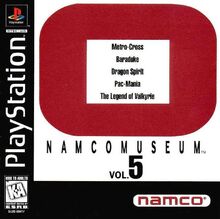
Namco Museum Vol. 5 (NTSC-U/C) cover art.
Namco Museum Vol. 5 was released on February 28th, 1997 in Japan for the Sony PlayStation. It was later released in North America on November 26th, 1997, and in Europe on February 26th, 1998.
Like its predecessors, the game presents a large amount of memorabilia and history of the games, within a large museum, however, like Vol. 3, the museum has been redesigned with a unique architecture, with elevators, stairs, and multiple floors, including a basement for one game, that being Baraduke. It also, like it's predecessors, uses JAMMA emulation to recreate the games, which is done really well here.
This compilation contains the following games, in order of when they are said in the commercial:
- Valkyrie no Densetsu (Localized as "The Legend of "Valkyrie"" in International releases)
- Baraduke
- Dragon Spirit
- Pac-Mania
- Metro-Cross
Namco Museum Encore
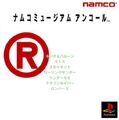
Namco Museum Encore
Namco Museum Encore was released on October 30th, 1997 in Japan for the Sony PlayStation. It is the only Namco Museum title on the PlayStation to be released only in Japan. It is believed or rumored to have not released Internationally either due to poor sales of the previous collections in those areas, or due to the contents included in some games in this collection (Wonder Momo being a tad risqué, and Rompers including an enemy using drugs).
Unlike its predecessors, the game goes for a unique kind of museum, as you no longer walk around a museum itself, but rather look around a spaceship with the games in it, and the receptionist. All of the exhibits are also attached to the game machines themselves, which you can now inspect, just like how they would be in real arcades. Like its predecessors, however, JAMMA emulation is still used to recreate games a faithfully as possible, which is done fairly well.
This compilation contains the following games, in order of when they are said in the commercial:
Namco Museum 64, Namco Museum (Dreamcast) and Namco Museum (Game Boy Advance)
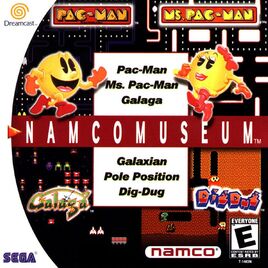
Namco Museum (Dreamcast) cover art.
Namco Museum 64 for the Nintendo 64, released on October 31st, 1999, and Namco Museum for the Sega Dreamcast, released on June 25th, 2000, both releasing exclusively in North America, were new titles in the franchise, for the first time, being available on non-Sony platforms. Another collection with similar games and music was released on the Nintendo Game Boy Advance worldwide on June 11th, 2001.
Unlike the collections prior, these entries in the series lack the museum that the series' name and fame were for, also lacking any bonus material, including DIP Switch options, flyers, test modes, etc. Test modes are in the game's code leftover in NM 64, but aren't implemented.
The GBA version was more basic, lacking Pac-Man, although this is more than likely a deliberate choice to market Pac-Man Collection, which was released around the same time, and also, infamously, lacking a high score saving feature. Despite these hiccups, NM on GBA sold 2.96 mil. units, making it the best selling Namco Museum to date, also being the
They contain a similar library of games, listed by the box art:
- Pac-Man (Not available on GBA, possibly to market Pac-Man Collection, being released around the same time.)
- Ms. Pac-Man
- Galaga
- Galaxian
- Pole Position
- Dig Dug
- PACit (Bonus V.M.U. exclusive game only available on Sega Dreamcast)
Namco Museum (PS2, Xbox and GCN)
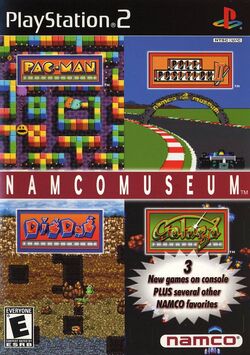
PlayStation 2 cover.
Namco Museum was released in 2001 for the Sony PlayStation 2 and in 2002 for the Nintendo GameCube and Microsoft Xbox, all exclusively in North America. The specific dates are unknown.
This entry doubles the amount of games from the previous entry, and is the first Namco Museum to include a non-arcade title, being Pac-Attack, released for home consoles in 1993. The Sega Genesis/Mega Drive version is present here, evidenced by the sound. The game does lack the original title screen, however.
Aside from menu colors (White for PS2, Yellow/Purple GameCube, and Blue for Xbox) and the PS2 version having a menu with less animations and screenshots of games, rather than videos, the games are practically identical for every console.
The games included, as presented by the menu and manual:
- Pac-Man
- Pac-Man Arrangement (1996)
- Galaga
- Galaga Arrangement (1995)
- Dig Dug
- Dig Dug Arrangement (1996)
- Pole Position
- Pole Position II
- Ms. Pac-Man
- Galaxian
- Pac-Attack (Unlockable)
- Pac-Mania (Unlockable)
Pac-Attack is unlocked by scoring either 20,000 points (PS2 & Xbox) or 15,000 points (GameCube) in Pac-Man. Likewise, Pac-Mania is unlocked by scoring either 25,000 points (PS2 & Xbox) or 20,000 points (GameCube) in Ms. Pac-Man.
Namco Museum (PSP)
Namco Museum was released on February 24th, 2005 exclusively in Japan for the Sony PlayStation Portable. It would later be released in North America under a different name, seen below.
This is the first Namco Museum title to use actual arcade roms to run the games through emulation, which is done fairly good here. It also includes its own Arrangement titles, although they have nothing to do with their 1990s counterparts seen in the previous Namco Museum title.
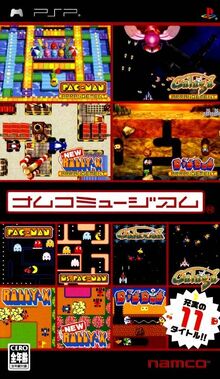
The cover art for the game.
You also can play with others, or share a game with another using the Ad-Hoc mode on the PSP to wirelessly transmit a demo of one game, or play together in multiplayer, although playing multiplayer requires two copies of the game.
The games featured, as presented by the box art:
- Pac-Man Arrangement (2005)
- Galaga Arrangement (2005)
- New Rally-X Arrangement
- Dig Dug Arrangement (2005)
- Pac-Man
- Ms. Pac-Man
- Galaxian
- Galaga
- Rally-X
- New Rally-X
- Dig Dug
Namco Museum Battle Collection
Namco Museum Battle Collection was released on August 24th, 2005 in North America for the Sony PlayStation Portable. It was later released in Europe on December 9th of the same year.
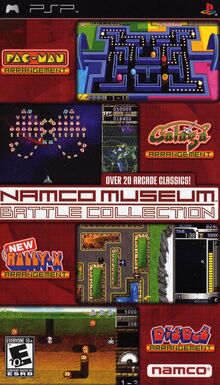
Cover art for the game, showing the new Arrangement titles.
This collection is the International release of the previous Namco Museum title only released in Japan on the same console, albeit with extra games. These extra games would later be released in Japan in a later title, Namco Museum Vol. 2, which can be seen below. This was the largest Namco Museum at the time, boasting 21 games. The name of the game is referring to the ability to play with others, or share the games with another, as the Ad-Hoc Mode abilities from the Japanese counterpart are also included here.
The games included, listed from left to right on the back of the U.S. cover:
- Pac-Man
- Ms. Pac-Man
- Galaga
- Galaxian
- Rally-X
- New Rally-X
- Dig Dug
- Xevious
- Bosconian
- Motos
- Mappy
- Grobda
- Rolling Thunder
- The Tower of Druaga (Labeled as "Tower of Druaga" on the back of the box)
- Dig Dug II
- Dragon Buster
- King & Balloon
- Pac-Man Arrangement (2005)
- Dig Dug Arrangement (2005) (Misspelled as "Dig Dug Arrangemen" on the back of the box)
- Galaga Arrangement (2005)
- New Rally-X Arrangement
Namco Museum 50th Anniversary
Namco Museum 50th Anniversary was released for the Microsoft Xbox, Sony PlayStation 2, Nintendo GameCube, Nintendo Game Boy Advance and PC, all in North America on August 30th, 2005 (aside from PC, releasing on October 25th, 2005), and in Europe on March 24th, 2006 (Xbox), March 31st (PS2 & GBA), May 5th (GCN), and May 19th (PC). It was also released in Australia only on PC on March 27th, 2006, and in Japan only on PS2, renamed Namco Museum Arcade Hits!, released on January 26th, 2006.

Nintendo GameCube (NTSC-U/C) cover art.
50th Anniversary was made to celebrate Namco becoming 50 years old, being founded in 1955, and it goes for a unique menu style, being presented as a virtual arcade space with all of the machines being put in a circle, but unlike the old titles, it has no bonus material, the games are the main content. Along with this new menu, some classic 80s music was chosen to play within the menu, evoking the feeling of playing these games in a real arcade.
Those songs are as follows:
- "Come On Eileen" by Dexys Midnight Runners
- "Working for the Weekend" by Loverboy
- "She Drives Me Crazy" by Fine Young Cannibals
- "Talking in Your Sleep" by The Romantics
- "Joystick" by Dazz Band
This collection is the first to use arcade roms on home consoles, however the GBA version does not due this due to technical limitations. The PS2 version of the game also was immediately released with a "Greatest Hits" label, no black label copies of the game exist in any way, at least not legitimately, in the NTSC-U/C region. This does not affect the actual game, but does irritate some collectors. The GBA version, much like the original Namco Museum for said platform, has a more limited game library compared to its console counterparts, and also lacks the ability to save high scores. The Japanese PS2 release, also unlocks the two unlockable games (see below) immediately, and replaces the licensed songs with original menu music, but other than these changes, and a name change (see above), the game is identical to the original American/European releases. The PC release also added back the ability to continue in games that allowed it (Pac-Mania, Dragon Spirit, Galaga '88, etc.), while all other releases lack the ability to do this.
The games included, listed from top to bottom on the back of the U.S. cover:
- Pac-Man (Available on GBA)
- Ms. Pac-Man (Available on GBA)
- Galaga (Available on GBA)
- Galaxian
- Dig Dug (Available on GBA)
- Rally-X (Available on GBA)
- Pole Position
- Pole Position II
- Xevious
- Dragon Spirit
- Bosconian
- Rolling Thunder
- Mappy
- Sky Kid
- Pac-Mania (Unlockable, excluding Japanese PS2)
- Galaga '88 (Unlockable, excluding Japanese PS2)
Pac-Mania is unlocked by getting 15,000 points in Pac-Man and 25,000 points in Ms. Pac-Man, in any order you wish. Likewise, Galaga '88 is unlocked by getting 40,000 points in Galaga.
Namco Museum Vol. 2 (PSP)

Namco Museum Vol. 2 was released on February 23rd, 2006 for the Sony PlayStation Portable. It is the Japanese continuation of the previous Japan only collection on the platform, released the previous year (364 days after, to be exact), and includes the other games included within battle Collection, which wasn't released in Japan, and includes a few extra titles.
The menu has a different color than Vol. 1/Battle Collection, but the collection of games is mostly unchanged from how they appear in Battle Collection, albeit with the addition of the new titles not present within Battle Collection. It also includes the ability to either play multiplayer or share games with others through the PSPs Ad-Hoc mode.
The games included, listed from top-left to bottom-right on the cover:
- Pac-Man Arrangement Plus (Only available in Vol. 2)
- Motos Arrangement (Only available in Vol. 2)
- Xevious
- Mappy
- The Tower of Druaga
- Dragon Spirit (Only available in Vol. 2)
- King & Balloon
- Grobda
- Dragon Buster
- Dig Dug II
- Motos
- Rolling Thunder
- Bosconian
Namco Museum DS
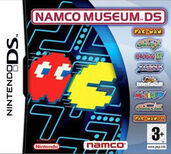
Namco Museum DS (PAL) box art.
Namco Museum DS was released on September 18th, 2007 in North America for the Nintendo DS. It was later released in Japan on October 11th, 2007, and in Europe on February 22nd, 2008.
DS is a substantial collection compared to the previous collections on Nintendo handhelds, and contains not only the games, but features such as a navigation feature (present in Galaga, Xevious, The Tower of Druaga and Super Xevious.) to help find hidden goodies within games, a jukebox, and even bonus material that made the series different than other compilations when it first released in the 90s. It also has the ability to save high scores, and you can use DS Download Play to either share a game with another, or to play Pac-Man Vs. in multiplayer with others who don't own the game, which like the original on the Nintendo GameCube, is required to play.
The games included, which are categorized by their release date on the menu:
- Galaxian
- Pac-Man
- Galaga
- Xevious
- Mappy
- The Tower of Druaga
- Dig Dug II (New is the default, but the old levels can be unlocked.)
- Super Xevious (Unlockable)
- Pac-Man Vs.
Super Xevious and the old levels in Dig Dug II can both be unlocked by flipping a special DIP Switch by inspecting the CPU Board while playing. To access Super Xevious, flip the game mode switch from Normal to Super, and with Dig Dug II, flip the version switch from New to Old. Once done, they will appear on the main menu to become easier to access.
Namco Museum Remix

Japanese cover, showing the different title.
Namco Museum Remix was released on October 23rd, 2007 in North America for the Nintendo Wii. It was later released in Japan on December 6th, 2007, in Europe on April 18th, 2008, and in Australia on May 1st, 2008. It was renamed to Let's Play Together! Namco Carnival in Japan. This name was chosen because the game seemed like an attraction park, so the name was changed as it seemed more accurate.
Remix has a blend of both the old Namco Museum titles, where you have a 3D space to travel, and the newer titles, as it mostly only features the games, with no bonus content to be found in game. This Namco Museum is unique, however for being the first Namco Museum to include a kind of Namco game that wasn't just an arcade game, being Gator Panic Remix, which is based on Wacky Gator, an attraction game that plays like whack-a-mole. The game menus allow you to control Pac-Man with similar controls to Pac 'n Roll and roam around the space to access the games by going into one of 6 entrances, one entrance for every Remix title, and one for the arcade, where all the classic games are presented.
An updated version of the game would be made in 2010, named Namco Museum Megamix, which has info listed below.
The games included, organized from screenshots (Remix Titles) and from left to right (Arcade Games) are as listed:
Remix Titles:
- Pac 'n Roll Remix
- Galaga Remix (Not the same as the Galaga Remix App Store game)
- Pac-Motos
- Rally-X Remix
- Gator Panic Remix
Arcade Titles:
Namco Museum Virtual Arcade

Cover art for the game, depicting most of the Live Arcade titles included (aside from Pole Position).
Namco Museum Virtual Arcade was released on November 4th, 2008 in North America for Microsoft's Xbox 360. It was later released in Europe on May 15th, 2009, in Australia on June 3rd, 2009, and in Japan on November 3rd, 2009.
Virtual Arcade is still to this day the largest Namco Museum collection in terms of titles included, being 34, and it includes not only classic games, but also includes Xbox Live Arcade titles, including those like Pac-Man Championship Edition. The game does not support Xbox 360 Achievements, although, this is because all of the Xbox Live Arcade titles have all of their Achievements intact, and available to collect.
Many things in this collection seem missing, or basic, such as there being missing settings to change, and no bonus material, leaving just the games themselves.
The games included, in order from top to bottom in their respective menus:
Xbox Live Arcade Games:
- Galaga Legions
- Pac-Man Championship Edition
- Mr. Driller Online
- Pac-Man
- Galaga
- Ms. Pac-Man
- Dig Dug
- Xevious
- New Rally-X
Museum Games:
- Baraduke
- Bosconian
- Dig Dug II
- Dig Dug Arrangement (2005)
- Dragon Buster
- Dragon Spirit
- Galaga '88
- Galaga Arrangement (2005)
- Galaxian
- Grobda
- King & Balloon
- Mappy
- Metro-Cross
- Motos
- Pac & Pal
- Pac-Man Arrangement (2005)
- Pac-Mania
- Pole Position
- Pole Position II
- Rally-X
- Rolling Thunder
- Sky Kid
- Sky Kid Deluxe
- Super Pac-Man (Labelled as Super "PAC-MAN" in the Museum Menu)
- The Tower of Druaga
Namco Museum Essentials
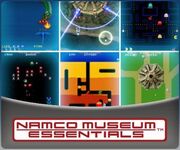
Cover image of the game, showing all of the games included.
Namco Museum Essentials was released on January 29th, 2009 in Japan for the Sony PlayStation 3 as a PlayStation Store exclusive downloadable title. It was later released in North America on July 16th, 2009, and in Europe on April 1st, April Fools Day, 2010. In Japan, the game was called Namco Museum.comm, which stands for communication, as the game has online capabilities, but was then renamed to Namco Museum Essentials in every other region.
It was released as a PlayStation Home title, which Sony was trying to push at the time. It also included an original game only available in this compilation called Xevious Resurrection, which was a new Xevious title complete with secrets, new graphics and sound, and simultaneous multiplayer gameplay.
It also had a demo you could download for free which included the first few levels from Pac-Man, Galaga, Dig Dug, and Xevious.
The games included, in order from left to right on the main menu:
- Pac-Man
- Xevious Resurrection
- Galaga
- Dig Dug
- Xevious
- Dragon Spirit
The game was delisted from the PlayStation Store in all regions, including its demo on March 15th, 2018. This was done presumably because there are other ways available to play most of these games available on the platform (Namco Museum Vol. 1 - 5 available on PS Store through PSone Classics, Encore included in Japan as well, and 20GB and 60GB Fat PS3 consoles can play both Namco Museum and Namco Museum 50th Anniversary due to backwards compatibility with PS2 games).
Namco Museum Megamix
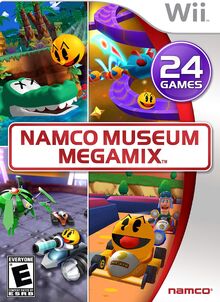
Cover for the game.
Namco Museum Megamix was released on November 16th, 2010 exclusively in North America for the Nintendo Wii.
Megamix is an update to Remix, being the same game but including more content, as it adds an extra Remix title, being Grobda Remix, an extra 9 arcade games, and a level select feature to all games, excluding Cutie Q. The games included, listed from left to right and top to bottom on the back of the cover:
Remix Titles:
- Pac 'n Roll Remix
- Galaga Remix
- Pac-Motos
- Rally-X Remix
- Gator Panic Remix
- Grobda Remix (New to Megamix)
Arcade Titles:
- Pac-Man (New to Megamix)
- Rally-X (New to Megamix)
- Pac-Mania
- Gaplus
- Super Pac-Man
- Xevious
- Bosconian (New to Megamix)
- Dig Dug II (New to Megamix)
- Galaga (New to Megamix)
- Mappy
- Pac & Pal
- Cutie Q
- Grobda (New to Megamix)
- Galaxian
- New Rally-X (New to Megamix)
- King & Balloon (New to Megamix)
- Dig Dug
- Motos (New to Megamix)
Namco Museum (Nintendo Switch)

Cover image for the game, showing the new logo for the series.
Namco Museum was released on July 28th, 2017 in all territories for the Nintendo Switch. It was not released on the other 8th generation platforms, the PlayStation 4 and Xbox One for 2 reasons, Xbox One and PS4 already had the Arcade Game Series, and it was a Switch exclusive to make the platform stand out more, being only almost 5 months old at the time of release. This new collection added some features like a challenge mode, where every game has its own challenge to complete, although it's the same challenge every time. There is also a remake of Pac-Man Vs., although this version is more comparable to the Nintendo GameCube original, rather than the stripped down and basic version available on Nintendo DS through Namco Museum DS.
The games included, in order of left-to-right in the main menu:
- Pac-Man
- Galaga
- Dig Dug
- The Tower of Druaga
- Sky Kid
- Rolling Thunder
- Galaga '88
- Splatterhouse
- Tank Force
- Rolling Thunder 2
- Pac-Man Vs.
A physical release bundled with Pac-Man Championship Edition 2 Plus, titled Namco Museum Arcade Pac, was released on September 28th, 2018 in all territories.
Namco Museum Mini Player
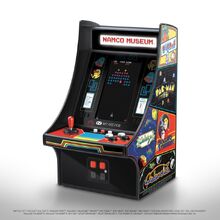
The Namco Museum Mini Player was licensed by BANDAI NAMCO Entertainment, and released by My Arcade in June 24, 2019.
- Pac-Man
- Pac-Man 2: The New Adventures
- Pac-Attack
- Pac-Mania
- Galaga
- Galaxian
- Dig Dug
- Dig Dug II
- Mappy
- Sky Kid
- Rolling Thunder
- Rolling Thunder 2
- Rolling Thunder 3
- Splatterhouse
- Splatterhouse 2
- Dragon Spirit
- The Tower of Druaga
- Xevious
- Phelios
- Battle City
Seventeen of the games are their original arcade versions, while the other three are games that originated on home consoles.
Gallery
External links
- Namco Museum Vol. official site
- Namco Museum Vol. 2 official site
- Namco Museum Vol. 3 official site
- Namco Museum Vol. 4 official site
- Namco Museum Vol. 5 official site
- Namco Museum Encore official site
- Namco Museum (Game Boy Advance) official site
- Namco Museum DS official site
- Namco Museum (PlayStation Portable) official site

